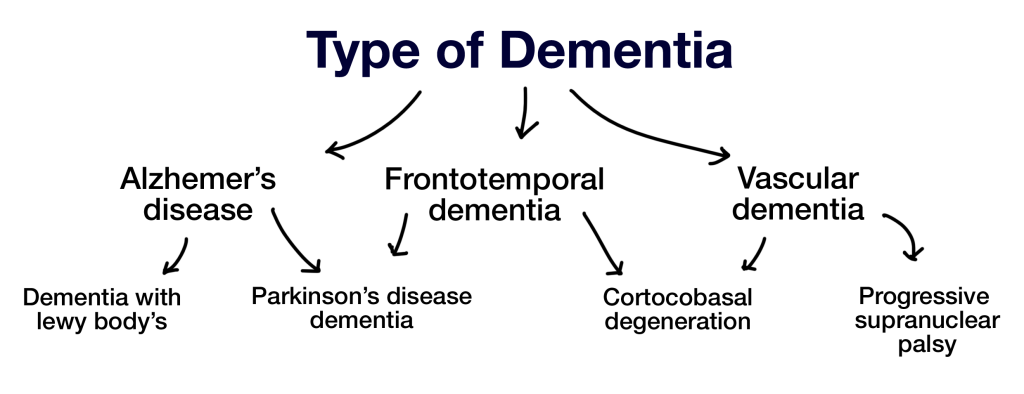Dementia is not one illness – rather, it is a term used to describe a variety of illnesses. These are the different types of dementia. Some common types are described below
Alzheimer’s Disease
Alzheimer’s disease accounts for more than 60% of dementia cases. This type of dementia is caused by damage to brain and nerve cells. Certain chemicals which are essential for transmitting information within the brain are also affected.
Alzheimer’s disease develops gradually over a period of many years. Usually, memory problems are the first to become apparent in a person with Alzheimer’s disease. Thinking is also affected significantly over the course of the disease along with the ability to learn new information, remember names, addresses, phone numbers, appointments, plans, etc.
Vascular Dementia
This form of dementia occurs when blood vessels or arteries which supply blood to the brain are blocked or become damaged. A person with high blood pressure, diabetes, high cholesterol levels or history of smoking is especially at risk for this form of dementia etc. In a way, vascular dementia could have a sudden onset following a stroke .
Depending on which part of the brain the stroke affects, the symptoms will differ with each person. Some common difficulties involve memory, language and concentration problems. Anxiety, mood swings and aggression are also common. Physical and motor functioning can also be affected in vascular dementia.
Lewy Body Dementia
Lewy bodies are proteins that sometimes get abnormally accumulated inside nerve cells which affects normal brain functioning. This can cause Lewy Body Dementia (LBD) as well as dementia caused by Parkinson’s disease.
A person with LBD will demonstrate the typical symptoms of dementia such as memory deficits and loss of daily functioning. This may be accompanied by poor executive functioning (planning, problem-solving, decision-making etc.) and problems with concentration. They may also experience auditory and visual hallucinations, have frequent falls and may have significant fluctuations in their functioning ability on a day-to-day basis. They are also very sensitive to the effects of a group of medicines called antipsychotics (Risperidone, Olanzapine, Haloepridol, etc.) used to manage hallucinations.
Fronto-Temporal Dementia
Due to degeneration or damage of brain cells in the frontal and temporal lobes, the functions that are dependent on these brain regions manifest as symptoms and deficits in this type of dementia. These include problems with planning and judgment; emotions, speaking and understanding speech; and certain types of movement.
Fronto-temporal dementia accounts for a large proportion of all cases of dementia affecting persons below 65 years. Typical symptoms include changes in personality and behaviour and difficulty with language.
The afore-mentioned types of dementia are among the most commonly occurring (in descending order) and account for at least 90% of all cases of the illness. However, it is important to note that the distinctions between these sub-types are not clear in some cases and symptoms may overlap.
Apart from the above, there are some types of dementia caused by conditions that are often treatable or reversible by timely medical and/or surgical intervention. These include –
- Depression: causes a ‘pseudo-dementia’ which can get better with antidepressants and talking therapies.
- Toxic reactions, like excessive alcohol or drug use
- Nutritional deficiencies, like vitamin B12 and folate deficiency
- Endocrine disorders such as thyroid hormone problems can cause memory problems
- Chest or urine infections and many other physical health problems including constipation or dehydration can lead to transient periods of memory loss and confusion. This is called delirium and can be reversed by initiating appropriate treatments.




